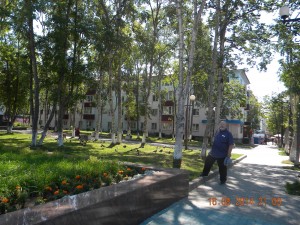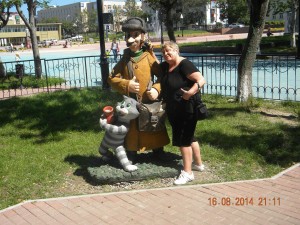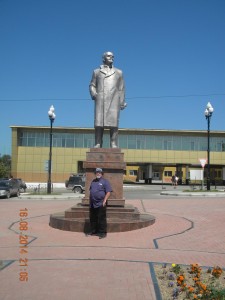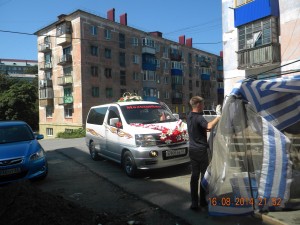 The next stop of the cruise ship was Russian town Korsakov on Island Sakhalin. In 42 kilometers south from Korsakov is situated the other Russian town Yuzhno-Sakhalinsk.
The next stop of the cruise ship was Russian town Korsakov on Island Sakhalin. In 42 kilometers south from Korsakov is situated the other Russian town Yuzhno-Sakhalinsk.
Tourists with the Russian passports rushed immediately for free tour around the island and up to Yu. Sakhalinsk. The rest part of the tourist crowd was allowed to walk about the town of Korsakov accompanied by guide explaining the history of the town and island itself. Little is known of the early history of Korsakov. The site was once home to an Ainu fishing village called Kushunkotan (in Russian sources, Taman-Aniva) which was frequented by trades of the Matsumae clan from as early as 1790.
Russian fort Korsakovsky was from 1853 till 1905, then it was handed over to Japan after Russian’s defeat in the Russian-Japanese war 1904-1905. Renamed Otomari was built into a stone-clad modern city, with paved streets and electricity.
After World War II, Otomari was again ceded from Japan, this time to the Soviet Union, and called Korsakov.
Now we are walking along the streets of Korsakov, a cute small town. We’re on the Lenin Square. Nobody destroyed this piece, here is seen the respect for history: there is a stella to fallen Japanese soldiers near Prigorodnoye (Merei before 1945) chausse.
 Local market on the Sovetskaya street offers great strawberries in the summer, and nicely prepared Korean delicacies (Kimchi and the local hit, the paporotnik, all year around).
Local market on the Sovetskaya street offers great strawberries in the summer, and nicely prepared Korean delicacies (Kimchi and the local hit, the paporotnik, all year around).
The demographic make-up is primarily ethnic Russian with a large ethnic-Korean minority.
Among the people on the streets we met by and large Russian-spoken people, with open faces and pronounced features of handsome individuals, men and women.
Look! The white birch-trees are familiar from the early childhood. Nearby the childcare garden was with Postman Pechkin and his companion cat Matroskin (wooden sculptures). We took pictures here.
Everywhere was felt the atmosphere of the Soviet Russian life with the new features of new type entrepreneurs: I saw wedding services machine.
Asking Janko about his impressions of Korsakov compared to Kushiro, he told that Japanese Kushiro is different in a way how they approach tourists. In Kushiro the people are more accommodating to visitors. Opposite, in Korsakov the people are not as exposed to visitors as in Kushiro. Why? Maybe, because Korsakov is still a military base and isolated from the foreign influx. So, the tourist infra structure is not developed yet. And it shows itself, walking on the streets, there is nothing to attract and hold your attention. The people seem to be hospitable and curious though.
Listen to: Georgy Nelepp, Folk Song of Sadko from N. Rimsky-Korsakov’s opera “Sadko”